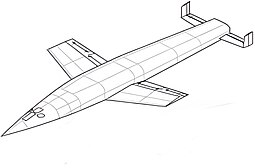Silver bird
The Silbervogel was a design for a suborbital bomber with a wingspan of 15 meters and a length of 28 meters that was created by Eugen Sänger and Irene Sänger-Bredt in the late 1930s .
designation
The design is sometimes referred to as the " America Bomber, " although it was only one of the designs for this mission. When Walter Dornberger after the Second World War in the United States attempted military interest in spaceships to awaken, he chose the diplomatic term antipodal bomber ( antipodes bomber from the Greek antipode , which is meant any point on the earth's surface on the other side opposite point ).
target
The design was noteworthy as it made use of new rocket techniques and the principle of a glider . In the end, the design was deemed too complex and expensive to implement. There were only wind tunnel tests.
The silver bird was supposed to realize long-distance flights with the help of a series of short jumps. At the beginning of its mission, the aircraft was supposed to be accelerated along a 3 km long railroad track by a rocket-propelled sled. Once launched, it should fire its own missiles and soar to an altitude of 145 km, where it would have flown at 22,100 km / h. Then it should gradually descend into the stratosphere , where the higher air density would have created a lift on the flat underside of the aircraft, which would eventually make it "jump" and soar to a greater altitude. The process would then have been repeated. Because of the air resistance , each jump would have been smaller than the previous one. However, it was calculated that the silver bird would have been able to Atlantic crossing, a 4,000-kg bomb on the American continent throw off and then his flight to landing somewhere in the Japanese continue part of the Pacific - a journey of 24,000 km.
Post-war analyzes revealed an error in the calculation of the aerodynamic heating on re-entry . The recalculation showed that the Silbervogel would have burned up on re-entry without course correction. Even so, it was not impossible to solve this problem, and after World War II the United States and the Soviet Union showed interest in Singer's work.
Technical advancement
In the USA, the project was the origin of the similarly constructed BOMI (Bomber Missile) from Bell under Walter Dornberger , as well as the later abandoned X-20 Dyna-Soar , a further development that was to be launched with a Titan II rocket . When the manned space flight cause of NASA was the retired US Air Force gradually back from manned space flight, and the Dyna-Soar was discontinued.
Stalin was fascinated by the concept and tried to have the singer kidnapped to the Soviet Union so that he could continue working on the design. When this plan failed, a new development office was founded in 1946 by Mstislav Vsevolodowitsch Keldysch to further research the concept. A new version powered by a ramjet (also known as a Keldysch bomber ) was developed but not built. The draft formed the basis for a number of new cruise missile designs in the early 1960s, which were also never realized.
A last remaining element of the Silbervogel design is the “regenerative engine”, in which the fuel or the oxidizer is routed in tubes around the combustion chamber and thrust nozzle in order to cool these parts on the one hand and to warm up the fuel on the other. Almost all modern liquid rocket engines use this design. Some sources still refer to this design as the Sänger-Bredt design .
Web links
- Juhani Westman: Global Bounce (English)
- Dan Johnson: singer America bomber. Retrieved on May 30, 2020 (English, on the page about the Silbervogel below a picture by Eugen Sänger and Irene Bredt).
Individual evidence
- ↑ Bell manned skip-glide space bomber project of the early 1950's. Predecessor to Dynasoar. , astronautix.com, accessed March 8, 2020
